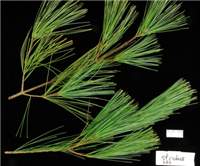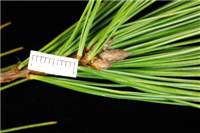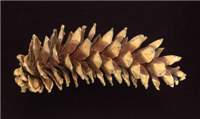Name
Pinus strobus L., Sp. Pl. 2: 1001 (1753).[Eastern white pine, Strobus pine, Weymouth pine]
Description
Habit: Small to large tree up to over 60 m in its natural habitat. Trunk usually straight and tapering, crown conic, broadening with age, becoming irregularly round-topped, sometimes developing heavy branches. Branch ends often erect with foliage in dense masses.
Bark: On young trees thin and smooth, greyish green to grey-brown, becoming darker and thicker with age and irregularly fissured and ridged into long, rectangular plates.
Foliage: Needles in 5s, 6-14 cm long, 0.7-1 mm wide, bluish green to dark green, lines of stomata on inner side, very slender, soft and flexible, may be slightly twisted, tending to droop.
Branchlets: Slender, greenish at first, becoming brown, ribbed, more or less covered with short hairs at first, later usually without hairs except for a patch below the base of the needles.
Winter buds: Small, c. 5 mm long, ovoid-cylindric, pointed, resinous, orange-brown to red-brown, scales pointed, tightly pressed but some free at tips.
Cones: Solitary or clustered, pendulous, with long recurved stalks 2-3 cm, narrowly cylindric, often curved, tapering towards the tip, 7-20 cm long, 3-7 cm wide when open, light yellowish brown, very resinous, maturing in 2 years, shedding seeds and falling soon after. Cone scales thin, flexible, exposed end rounded, umbo smooth, pointing forward except near base. Usually a few basal scales reflexed.
Seeds: Small, 5-6 mm long, tapered at both ends, red-brown, mottled black, with a narrow pale brown wing c. 15-25 mm long.
Notes
Can be distinguished from other 5-needled pines by the horizontal masses of blue-green foliage pointing forwards, patches of hairs below insertion of leaves and slender, often slightly curved cones.
Natural Distribution
E U.S.A.


